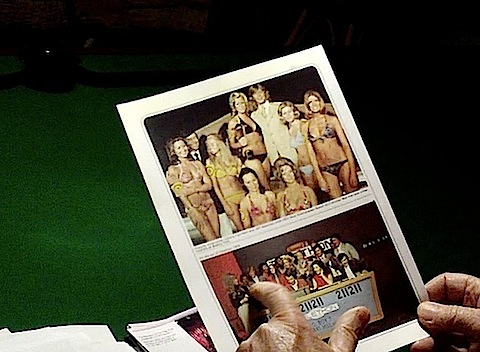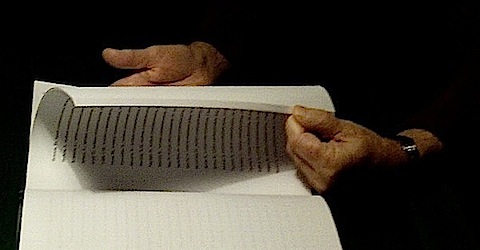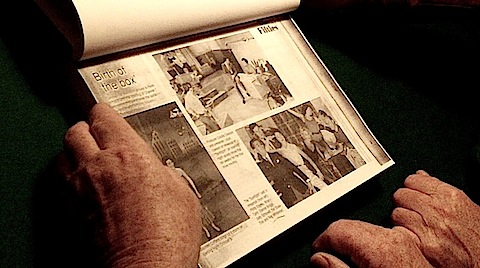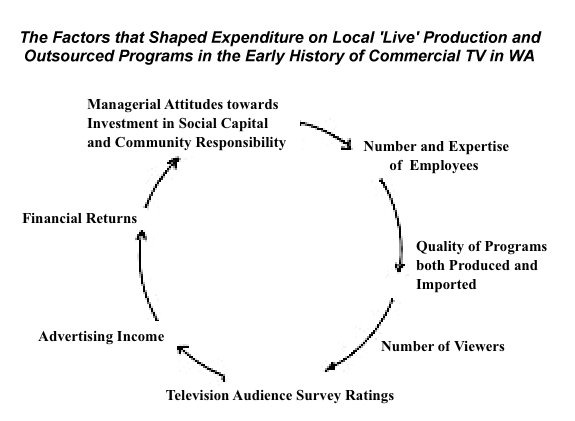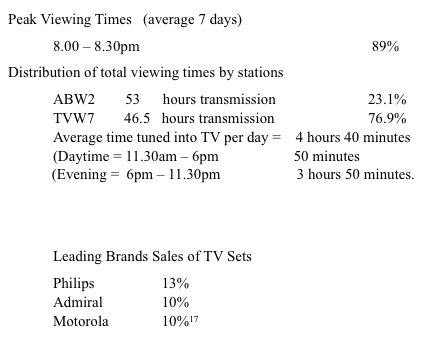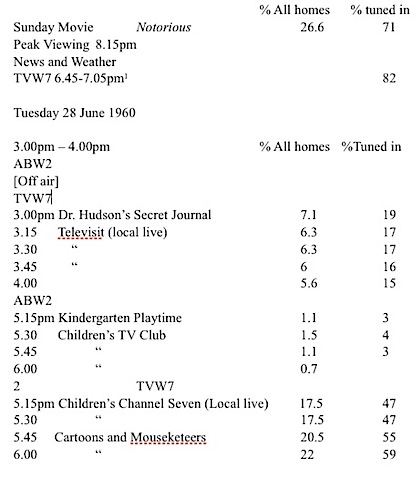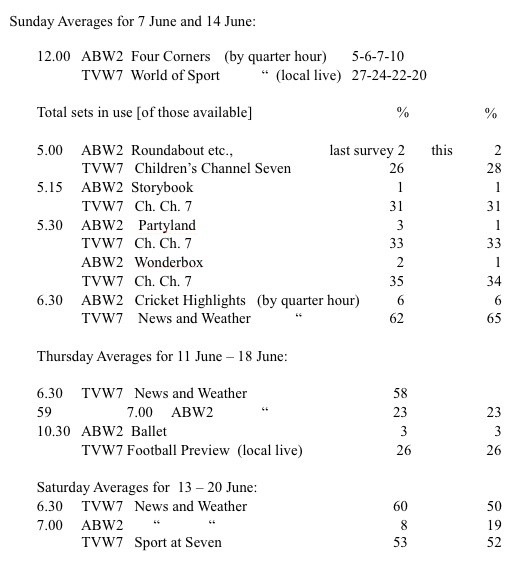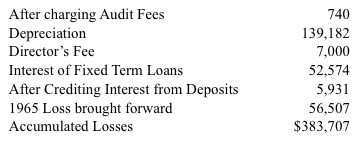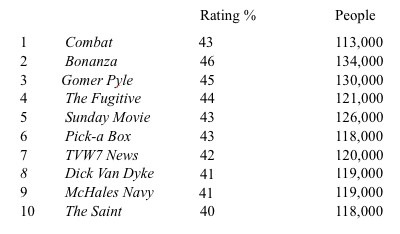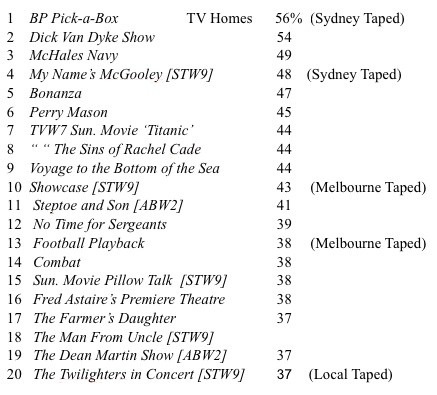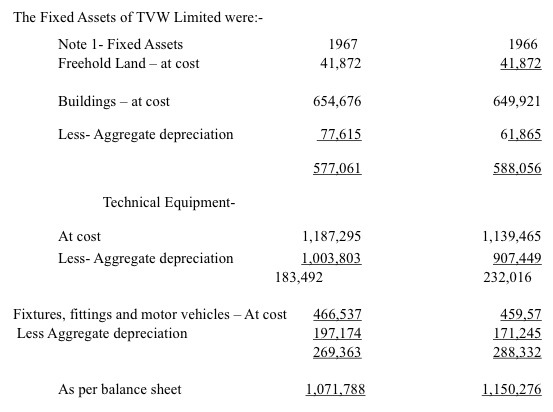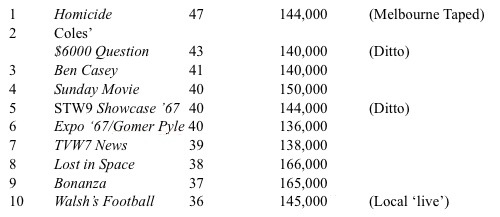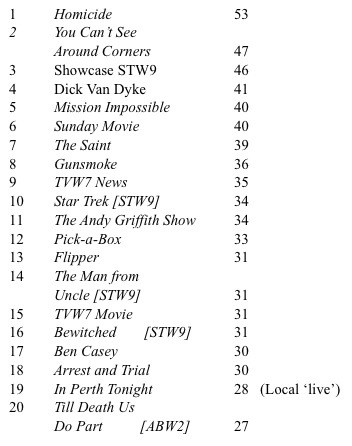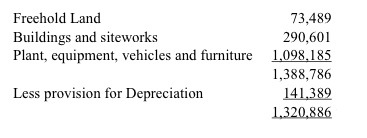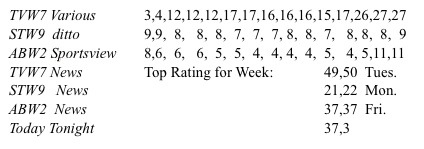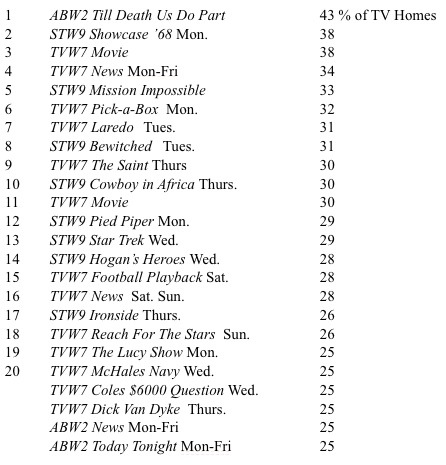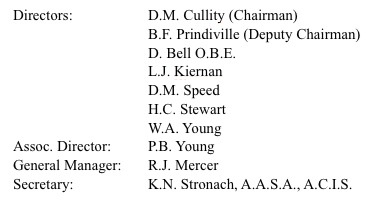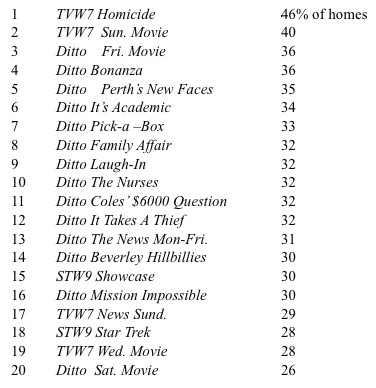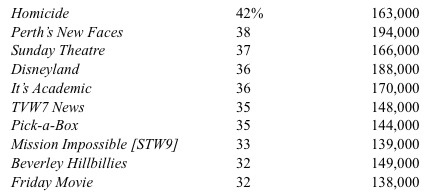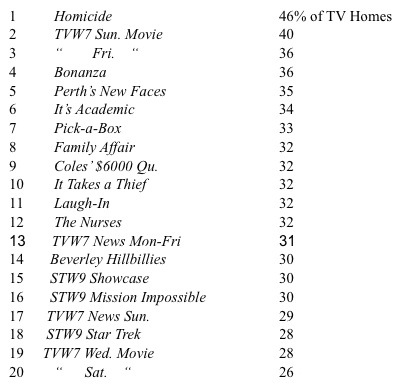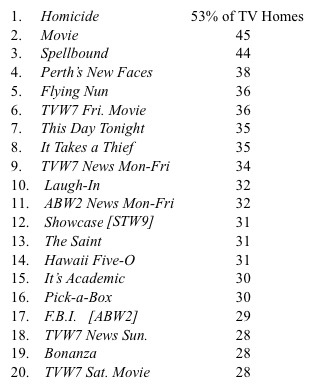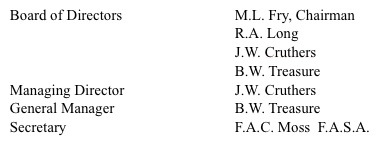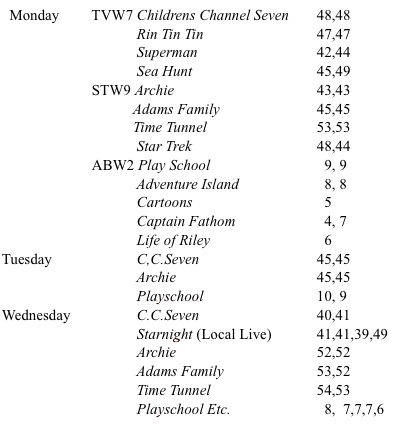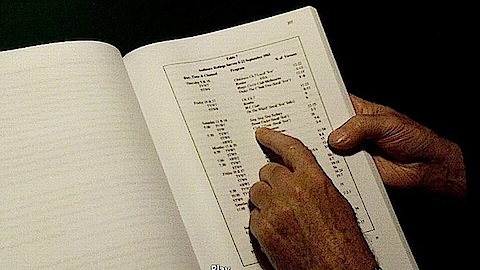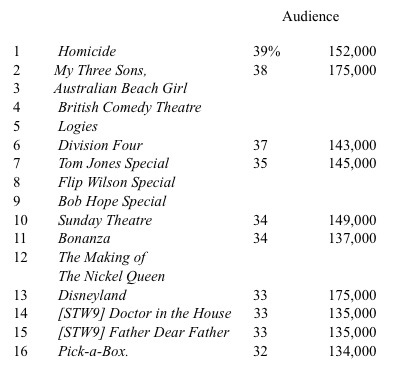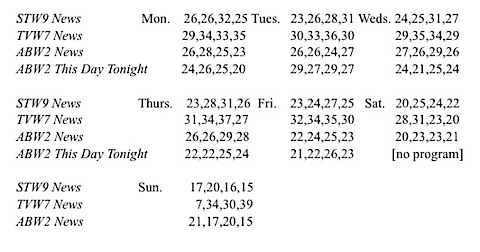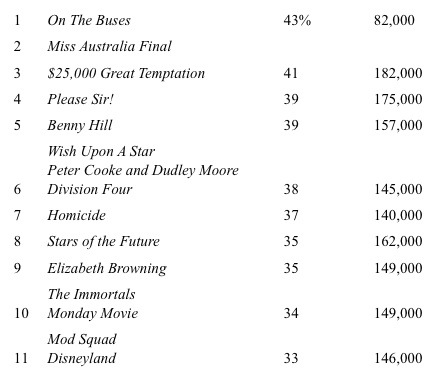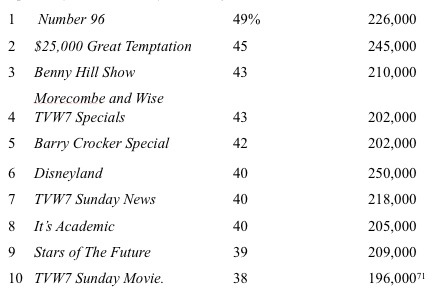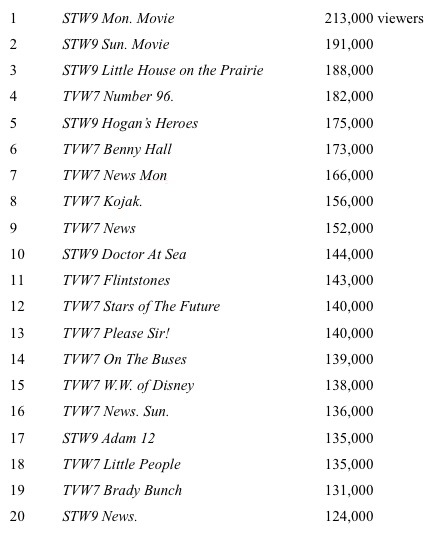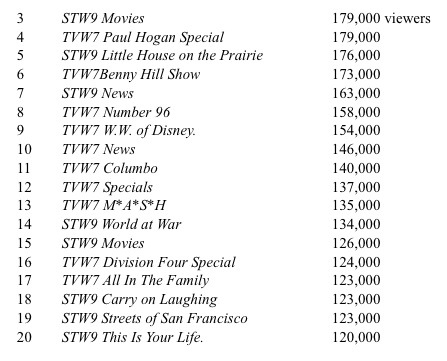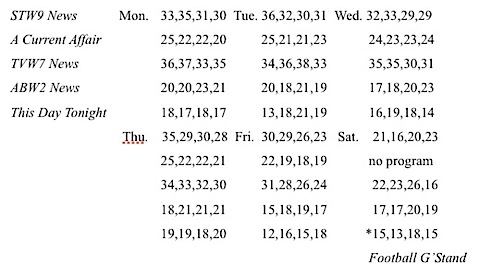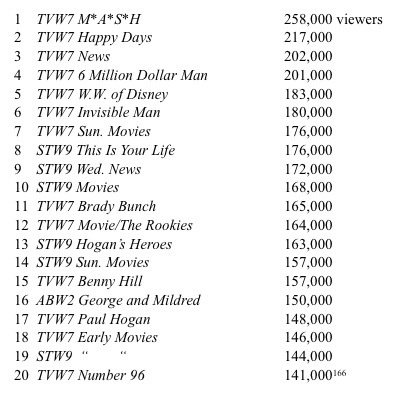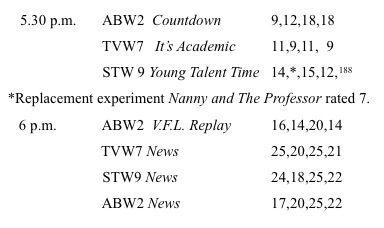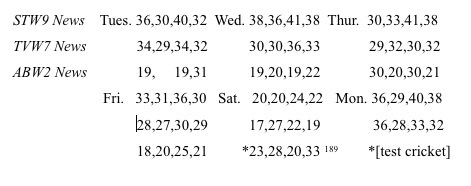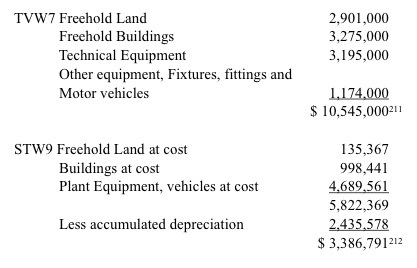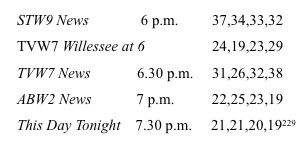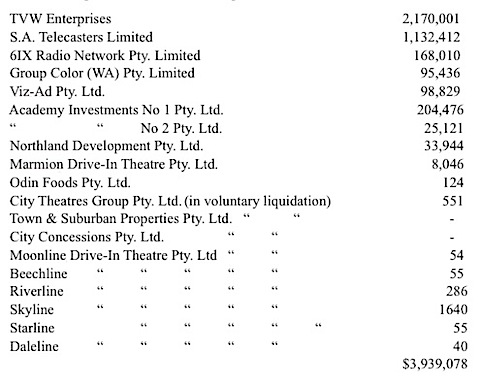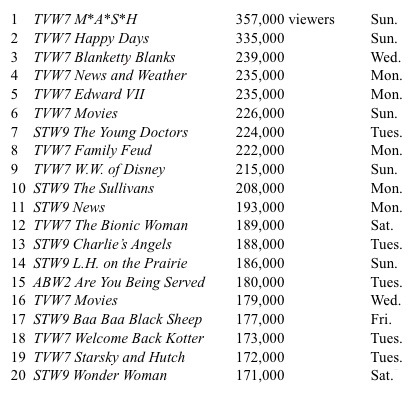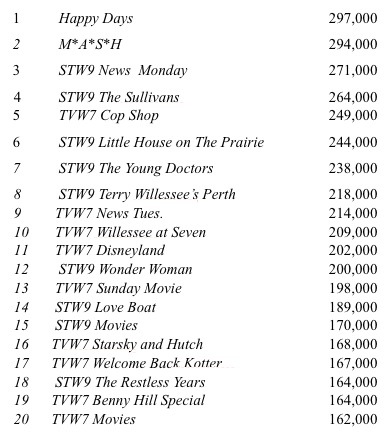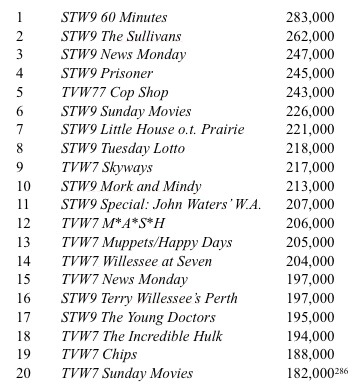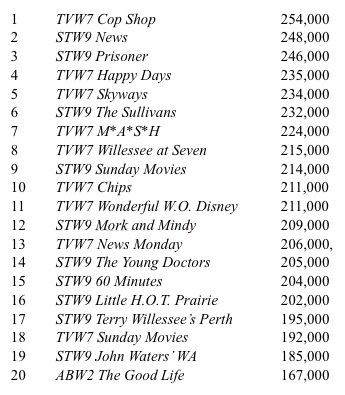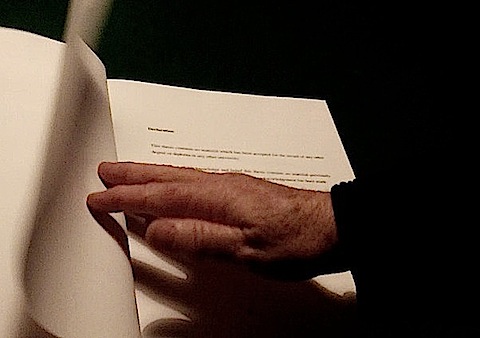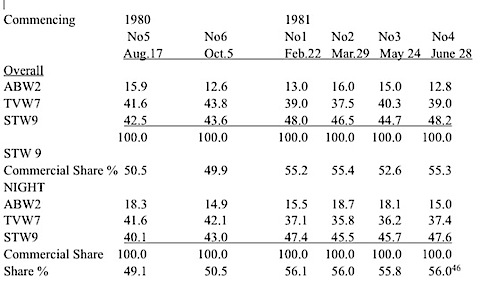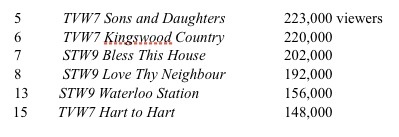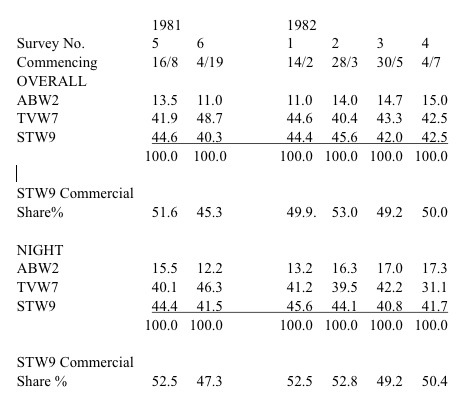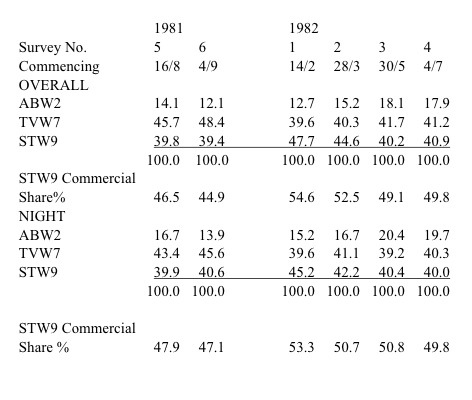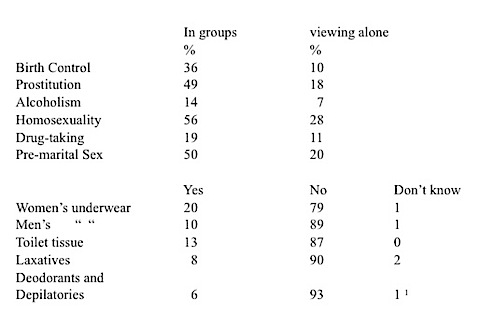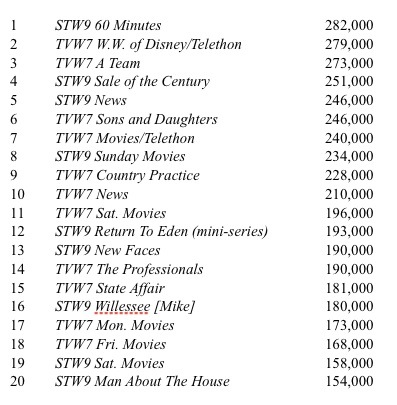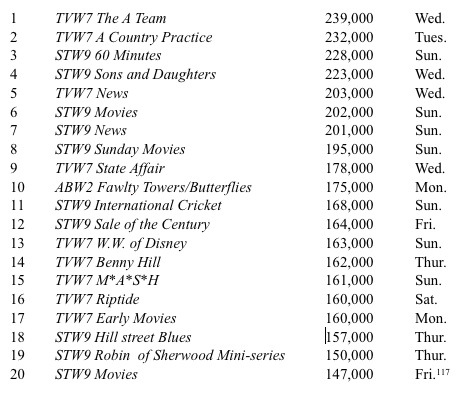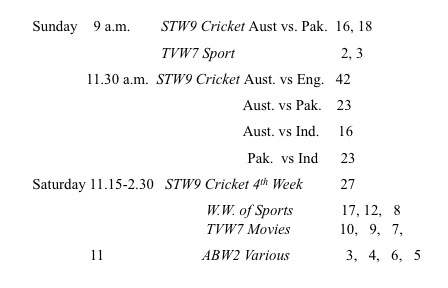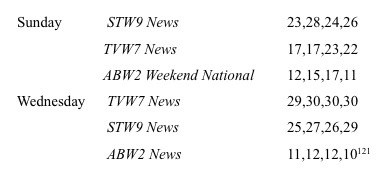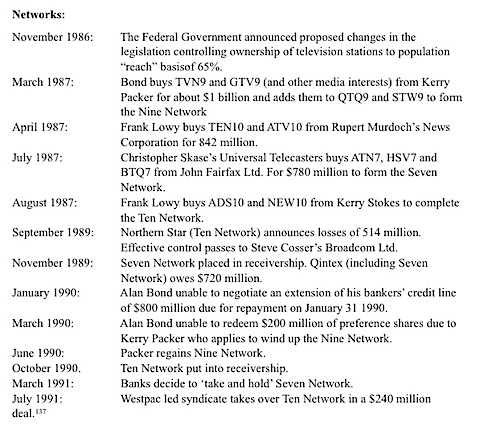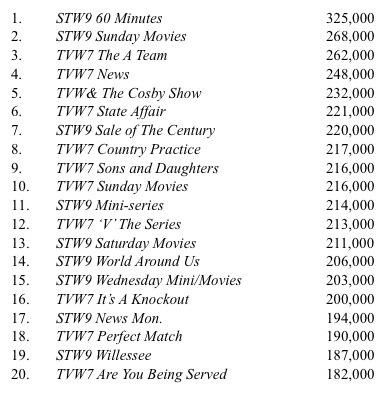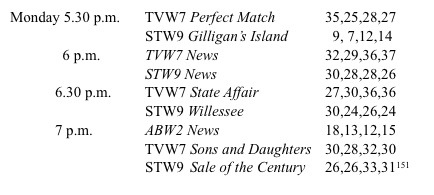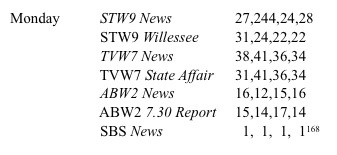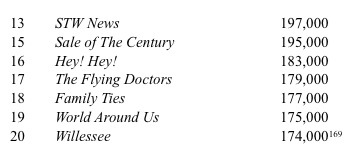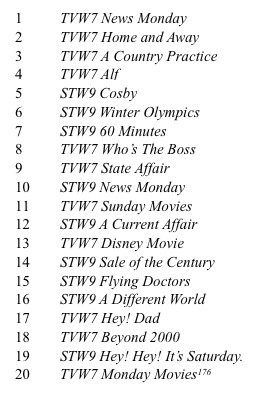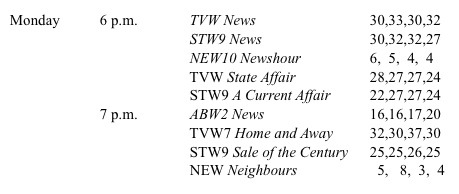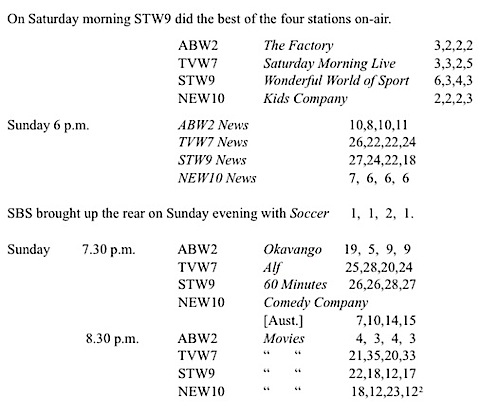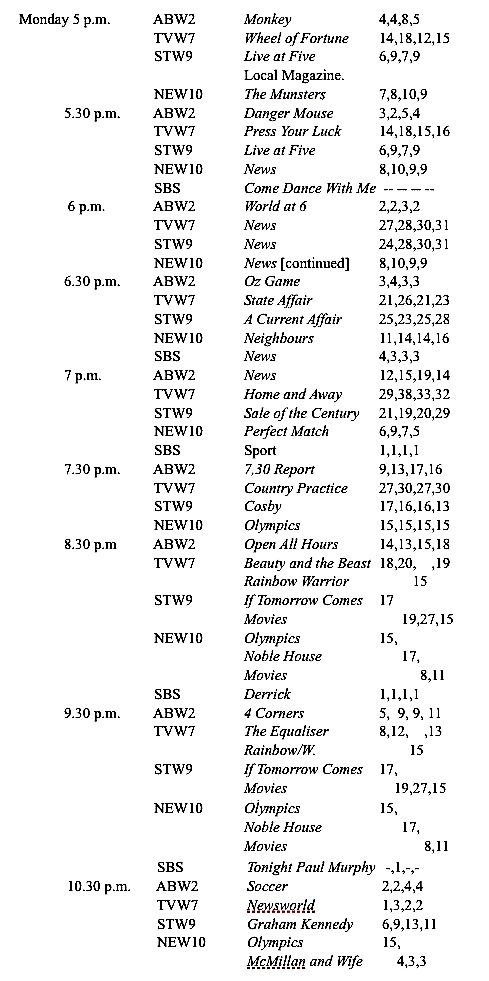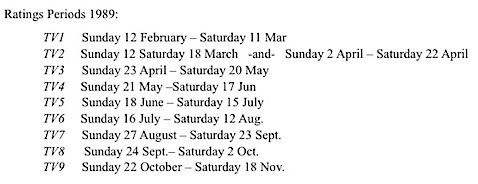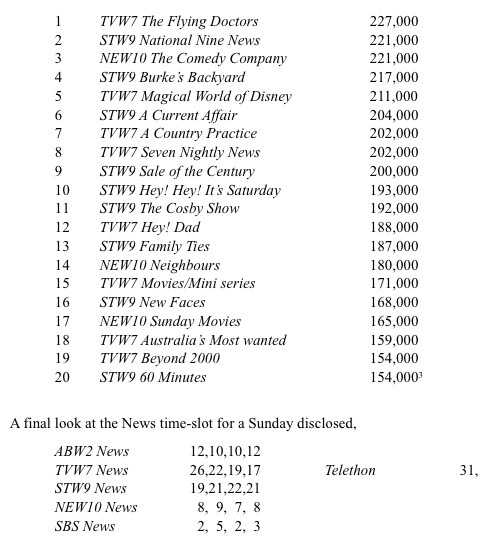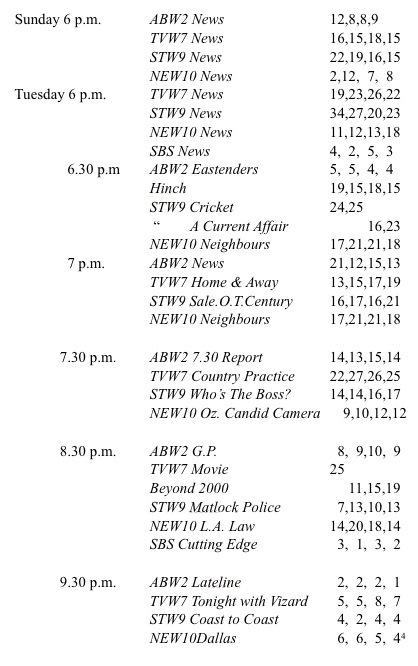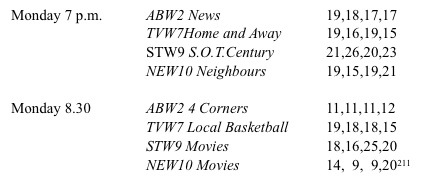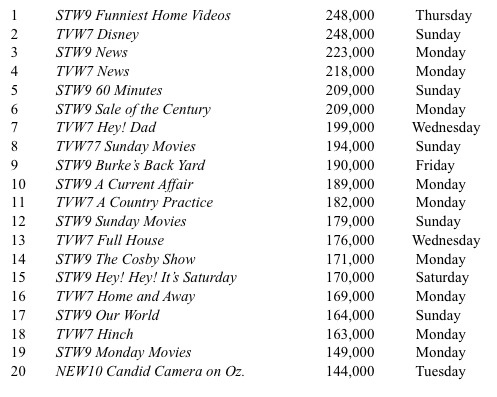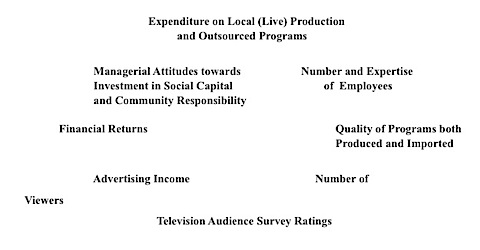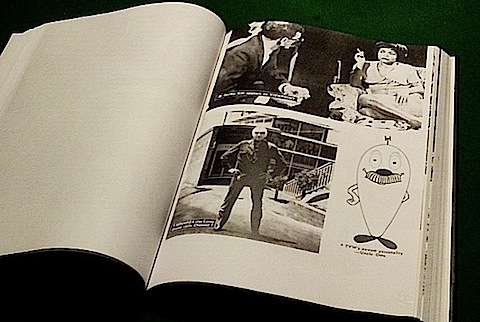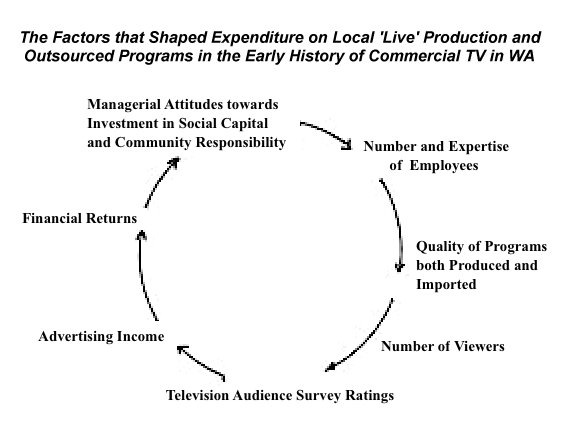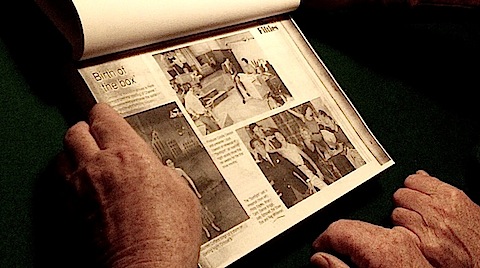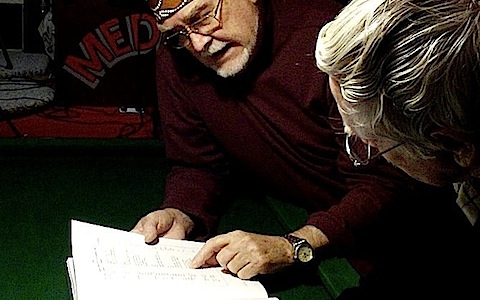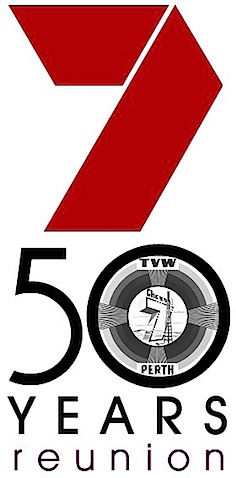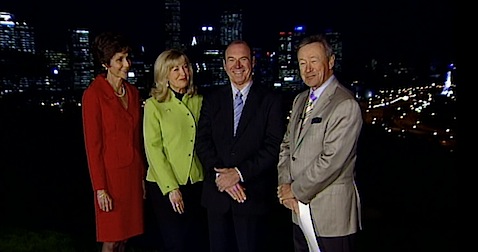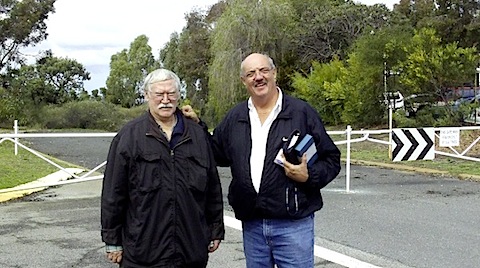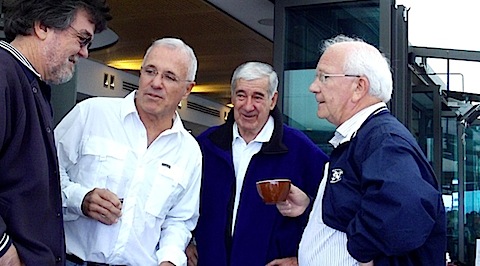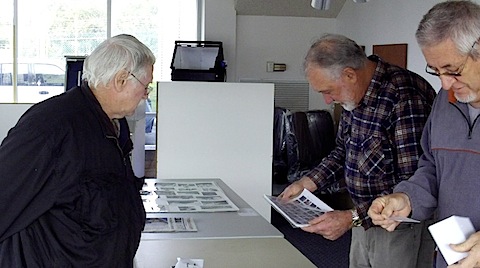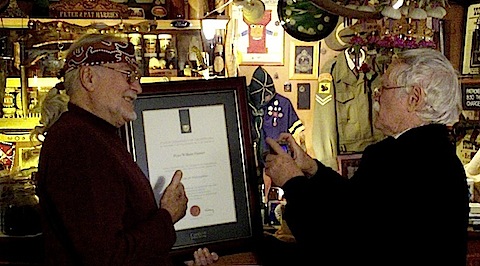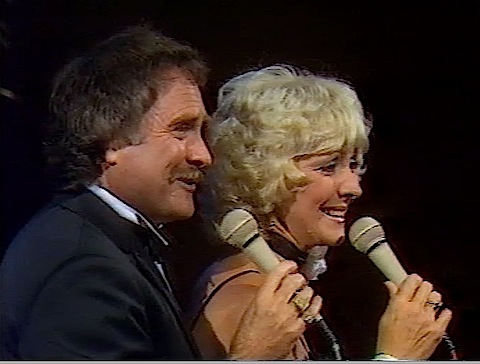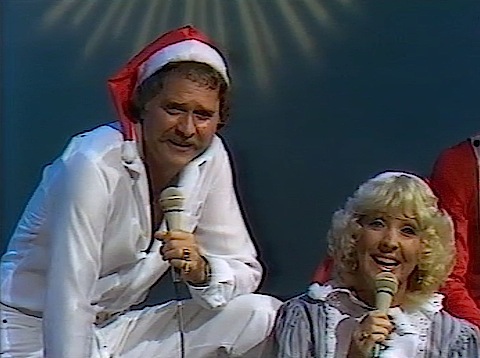This page forms part of Dr Peter Harries’ first PhD thesis submission entitled: “From Local ‘Live’ Production Houses to Relay Stations: A History of Commercial Television in Perth, Western Australia 1958-1990″. This contained much additional material.
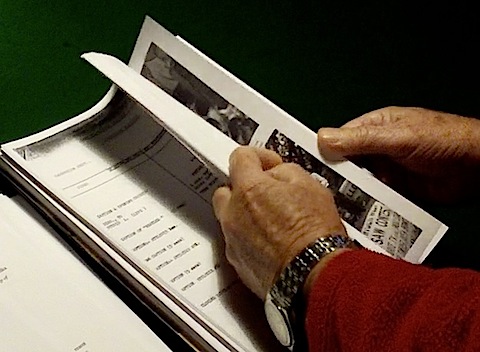
Chapter Four:
Examination of the Growth and Decline of Local ‘Live’ Television in Western Australia. What really happened?
Introduction:
It has been said that ‘Television is both a component of daily life, part of our world of custom, and also a set of artistic practices.’ It is these ‘artistic practices’ that this chapter examines along with the evolution of Local ‘Live’ television in Western Australia as exemplified by Children’s, Women’s, Teenage, Talent Quest, Quiz and Tonight Shows. It also presents answers to the question: ‘To what do you attribute the disappearance of local ‘live’?’ While the foregoing chapter dealt with the effects that ratings and advertising revenue had upon local ‘live’ production, it may become in the future a matter of conjecture, as to how the disappearance of most local ‘live’ production was perceived by those who had participated in the medium. To this end it is helpful to examine more closely some of the types of programs which were introduced and terminated in the period 1959 – 1990, before looking at the reasons.
As was the intention of TVW7 (as described in Chapter 1 of this thesis), local ‘live’ production was to cover the areas of Local General [which included Special Presentations], Women, Children, News, Sport, Educational and religious. This was maintained as station policy and copied by STW9 in 1965. The Children’s area was specially catered for and likewise Women’s, Teenager’s, Talent Quest, Quiz and Tonight Shows were regular features. It was recorded in 1960 that, ‘Perth: After only six months telecasting, TVW7 has achieved an Australian content of 39.9%.’
In accord with Bonner’s contention that ‘Most ordinary television programmes are performed live rather than actually ‘live to air’’, for the purposes of this thesis, the term local ‘live’ production is applied to programs that were produced in (or from) Perth Western Australia, whether they were actually spontaneous transmission of actual events, or recorded on videotape or film. The term ‘local’ applies to Western Australian television as opposed to the Eastern States interpretation of being Australian.
Although Hartley said that it was ‘never clear what “live television” encompassed…’, in Western Australia it has always been regarded by the viewing audience as the local product. While it is true that actual live transmissions carried a degree of risk, in both areas of presentation and technical control, the introduction of videotape provided the opportunity for a more controlled form of production. The continuance of a ‘local’ appreciation by the viewing audience, in regarding the product as ‘live’ has been dismissed as a ‘myth’. Hartley said that ‘liveness’ made television a more dramatic event for the audience as they didn’t know what might happen next. This is true, but in Western Australia, the taping of such programs as the Martin St. James hypnotism show ‘Spellbound’ both maintained the suspense of not knowing the impending, while preserving the actuality on videotape. This demonstrates that there was an attitude of honesty by management towards the audience and this responsibility has been dealt with in Chapter Three. Although Hartley also said, ‘ “Live” is opposed to “canned”, “recorded” ’ in Western Australian television (in most instances), recording was a practical means of portraying reality.
The production of local ‘live’ programs was an amalgamation of artistic talent. Apart from the eventual purveyors of human actuality (the on-air personalities), the artists included: ‘Television writers, editors, directors and producers [who] are the agents in making meaning.’ Without these intermediaries the ideas could not become actuality. In the case of the television ‘personalities’, those fortunate enough to get their heads on the small screen were instant figures of fame, who became, ‘…at least for a moment – celebrities who belong to everybody, who immediately become ours.’ Such was the case in Western Australia, where the viewing community idolised their ‘stars’.
O’Regan confirms that Perth produced ‘chat shows, variety shows, tonight shows and new programs which attracted high ratings’ but does not include the daily in-studio children’s and women’s shows. These programs were ‘low cost, live television for the local service area…’ After technology and networking destroyed the ‘local’ production industry, ‘lower cost local production’, important in the areas of ‘infotainment, news and current affairs’ to sustain the feeling of ‘localism’ in the parochial sense continued, while allowing most other production to be based in the Eastern States capitals. With the exception of the fund-raising ‘thons featuring Soap Stars (supported by non-paid Perth artists, both amateur and professional) variety programs have disappeared in Perth.
The ‘Eastern States’ interpretation of ‘local’ can be determined from a Department of Communications publication of 1984 which said,
In Australia the concept of localism is nearly as old as broadcasting itself. It has been one of the main themes underlying the purpose of legislation, policy and planning associated with broadcasting over many decades and is one of the central components of our present scheme of broadcast regulation.
The term ‘localism’ meant Australian and the regulations imposed to preserve a high percentage of ‘local’ content. However, in the same document, a paradoxical situation arises wherein it is stated that ‘local owners are more able and ready to interpret, appreciate and respond to the needs of their own community.’ It also acknowledged that ‘local ownership and control’ leads to a strong identity, countered media ownership concentration, financially benefited local residents and induced ‘dedication and willingness expected from the community’. The ambiguity is negated in a following clause 3.51 which makes it clearer that the references are to radio stations. However, it was later said that current government policy and legislation recognise the responsibility of a commercial television licensee to broadcast programs of interest and relevance to the particular community within the station’s service area, including a degree of locally produced material. The controllers of 1984 were not consistent in their interpretation of ‘local’. In 1988, Spurgeon commented that ‘Localism, by economic necessity, requires a minimum of relatively low-labour and resource intensive programs, in local television services.’ he went on to note that Government regulators did not acknowledge ‘local programs’ in favour of ‘Australian programs’ and concluded that with the changes to the television industry would benefit the ‘Australian programs’ with ‘local programs’ and services being ‘…the first casualties…’ Spurgeon displayed great insight and prophecy in suggesting that complacency would lead to a situation which would be ‘…highly centralised and ‘national’ in character…’ then concluded with this thought, ‘To paraphrase one regional television executive: the loss of localism from regional services will be a lot like losing freedom. You’ll only miss it when you no longer have it.’
In 1992, David Morley wrote on the importance of ‘We are your local station!’ Quoting Halloran he said that the ‘…real task for the mass communications researcher is…to identify and map out the different sub-cultures and ascertain the significance of the various sub-codes in selected areas governed by specific broadcasting or cultural policies’ This advice could well be heeded by those who ignore the western third of the continent. To consolidate the notion that Australia finishes at the last black stump west of Sydney, Cunningham and Jacka (like most of their Eastern States counterparts), chose to ignore the situation in Western Australia by stating that ‘…since the 1960s the commercial television industry has contracted out virtually all of its production, except news and current affairs…’ It was also recorded that ‘In the commercial sector drama, quiz and game shows, documentary, and children’s programming were produced by independent production companies.’ Not so in Perth! With the exception of drama (and STW9 even had a tilt at that with The Drifter) all of those shows and more, were produced in the studios of TVW7 and STW9. However, three years previously, Turner and Cunningham had acknowledged the existence of ‘Television stations…licenced to service particular local areas, be they metropolitan or regional’
The controlling body which allocated the licences supposed that concerns and local ownership would reflect ‘localism’, but the growth of networks was not envisaged. The ‘unofficial’ history of television in Australia is the story of the rise of ‘de facto’ networks, which were not subject to regulatory control. By ‘unofficial’ it is meant that they were loose collaborations of interstate stations, usually bearing the same call-sign designation. The principles of networking and localism have contested the industry with the result invariably being loss by the latter. In 2000, Turner reinforced this contention and added that it wasn’t till the late 1980s, with the introduction of the ‘audience reach’ rules, that ‘..a form of de facto recognition was finally achieved.’
Networking arose in the large capital cities by amalgamation of commercial interests. In regional areas, where there was only one station (and in the case of Perth, two colluding stations) they held onto their positions of monopoly to fight against increases in the price of imported and Australian programs. In doing this they also raised a buffer against network The granting of a third licence for Perth meant that eventually there would be a reduction in the power of TVW7 and STW9 which would eventually lead to Seven network control of the former and an affiliate-network association by the latter with the Nine network. The licence granted by the Government control body meant that the Broadcasting Control Board policy would consolidate the potential power of the networks and this is what happened. In 2001 the construction of the Australian networking system had become:
Seven Network Ltd Public company controlled by Kerry Stokes
5 Capital
1 Regional
Affiliates 5 Regional
Nine Network Ltd Wholly owned by Publishing and Broadcasting Ltd and controlled by Kerry Packer
3 Capital
1 Regional
Affiliates 2 Capital
5 Regional
Ten Group Ltd Public company owned by TNQ Television Ltd
5 Capital
Affiliates 5 Regional
TWT Holdings Pty Ltd Wholly owned by Bruce Gordon
9 Regional
1 Remote
Prime Television Ltd Public Company controlled by Paul Ramsey
7 Regional
1 Remote
Southern Cross B’Casting Aust. Ltd Public company controlled by Ten Group Ltd
1 Capital
4 Regional
Telecasters Aust. Ltd Public company controlled by Ten Group Ltd Controlled by Permanent Trustee Co Ltd and Ten Group
3 Regional
1 Remote
Spencer Gulf Telecasters Ltd Public company controlled by the Sturrock Family
2 Regional
Imparja Television Pty Ltd Company controlled by the Central Australian Aboriginal Media Association and the Aboriginal and Torres Strait Islander Commission
1 Remote
NBN EnterprisesPty Ltd Wholly owned by Washington H Soul Pattinson
1 Regional
Sunraysia Television Ltd Public company controlled by Eva Presser and Bruce Gordon
1 Capital
In 1985, an un-named observer in an official Department of Communications Report said, ‘The ABT believed that if the structural imbalance it identified was not corrected soon, commercial television would inevitably become centred on Sydney and Melbourne, and would remain so indefinitely.’ The problem was known, commented upon and a suggestion made that there could be an aggregation of regional and State resources ‘…to provide a healthy level of Australian production and employment’. There was knowledge of the situation, but no steps were taken to correct the trend.
In 1991, the Australian Writers Guild (WA) called on the regulatory body to introduce direction for ‘…Regional Drama Production within the Australian Content Quota System.’ This would have the effect of leading television stations to look after ‘local’ communities under Section 86 (10) of the Broadcasting Act, which would lead to a better sharing of ‘Australian creative resources.’ Grant Noble expressed a similar plea to the Government sponsored inquiry, ‘…regional identity can only be fostered by Australian content, parts of which must also be ‘local’ content in terms of local production and control.’ They were voices crying in the wilderness.
Western Australia 1959:
Rolf Harris and Childrens Channel Seven:
In 1959, the Western Australian born entertainer Rolf Harris was personally engaged in England by James Cruthers to fulfil a twelve months contract at a salary of forty pounds per week, which at the time was more than the CEO himself earned. It also included transportation for Harris and his wife to and from Australia, repayable if the contract was not honoured. Harris produced the afternoon Children’s Channel Seven, making good use of friends from his former study years. These included the naturalist Harry Butler ‘…bringing all the snakes into the studio!’ Vincent Serventy; Pat Thomas ‘The Pet Lady’ and Irish writer and actor Colm O’Doherty. Harris provided the bulk of the show with singing, drawing and puppets. He was replaced for a week during the year by actress Dianne Briggs and station presenter David Farr.
Former cameraman Richard Ashton remembers Harris thus:
…he was very neat and tidy about his work. Didn’t like fools particularly. If you weren’t good at what you were doing he was probably a bit severe and on television he was very clever…I mean some of his paintings you know with a big pot of paint and he’d go whoosh and suddenly he produced this lovely image of a cow…really some of his hand-puppets he made…you’d kill yourself laughing.
In April of 1960 TVW7 announced that it had added a further two hours per week to its children’s viewing times. 17-year-old Carolyn Noble (who was also required to work a normal day in the office) at 5.45 p.m. donned her mouse-ears to ‘hostess’ a fifteen minute session each night before the Mickey Mouse Club. It was reported said that she had been chosen from a screen-tested group of potential club leaders, but as she was the regular baby-sitter for the children of the General Manager James Cruthers, it must be acknowledged that she probably had the inside running. That said, it is difficult to imagine a young woman more suited to the role that was chosen for her. She had young guests on-camera with her and after Rolf Harris returned to England in September 1960 (dates for Harris should come above), the program was enlarged, with co-host Gary Carvolth. Carolyn’s career continued until 1966 when she went to the United States for three years with her husband. Actor Jim Atkinson was employed as a booth announcer at TVW7 and he took over the helm of Children’s Channel Seven as Captain Jim, with Seaman O’Doherty and later Taffy the Lion (actor John Couzens) as his helpers. When asked about the amount of preparation that was done for any particular afternoon’s programme Atkinson said,
Oh, I think this week we’ll do a little bit of this and next week we’ll do a little bit of that. Puppets that we really knew very little about. Colm used to make up these stories, he’d put the stories together, and we used to make up our own on the spur of the moment. Puppet work and stuff like that we’d have to get together ourselves and do whatever we had to do to put it on, but there was no assistance from anyone. The children’s session was run by those on it, and that was all…
Atkinson went on to describe the situation regarding well known Western Australian personalities as naturalist Harry Butler, dog expert Pat Thomas and Kevan Johnston the first TVW7 character Percy Penguin. Atkinson’s female counterpart was Trina Brown, another Production Department office worker who also presented the weather bulletin during her time at TVW7. Children’s Channel Seven remained a constant feature on TVW7 continuing in various guises with Sandy Palmer, Ian Teasdale, Fat Cat (actor Reg Whiteman), Alison Carroll (later -Jung) and immediately before its demise, Keith Geary. Eventually it became a hosted cartoon and ‘strip’ program vehicle to fill the space generally considered to be children’s time. By the mid 1980s afternoon ‘live’ shows had ceased with Saturday morning editions of Early Birds and Zippety Doo Dah being the replacements. During school holidays they went to air each morning at 7 o’clock.
When STW9 opened in June 1965 the children’s sessions went to air each afternoon (from 3 or 3.30 p.m. to 6 or 6.30 p.m., depending on when the evening News was scheduled) as Peter Harries Presents. This was ‘hosted’ from Studio A, the presentation booth. There were three ‘Studio C’ presentations during the week. Charlie Punch and Me on Tuesdays, Under The Coolabah Tree with a live audience on Thursdays and On The Wharf on Fridays. In February 1966, new Production Manager Denzil Howson instituted a daily 45 minute ‘live’ show with 50-60 children in the audience. This program was produced by the host Peter Harries and Director Philip Booth. Following on from Howson’s time at GTV9 Melbourne, it was called The Channel Niners Club. The studio ‘set’ resembled the inside of a castle [to satisfy a boyhood desire of mine to have a ‘real’ club-house] and the audience was part of the general presentation and participation. It was regarded as being something of a treat to attend a session and many children attended as part of a birthday party. Peter Harries’ female counterpart was a young actress named Veronica Overton. Regular features included an inter-schools’ Quiz competition; a ‘science’ day when early secondary school children conducted suitable chemistry experiments; a segment on pet care sponsored by a dog-food company and children as guest entertainers. In June 1966 Howson’s long-time friend, Melbourne ventriloquist Ron Blaskett was brought to Perth to produce The Channel Niners Club which was expanded to include resident musician Peter Piccini and the station Newsreader Alan Graham was co-opted to play the part of bumbling (but likeable) stooge Useless Eustace. Actress Pixie Hale appeared on a regular basis as required to play such characters as Alice in Wonderland. Wednesday was ‘dress-up’ day and a ‘fairly easy for Mothers’ theme would be pirates, cowboys, Gypsies, Japanese, etc. There was a regular TV Dentist on Thursdays, complete with an elaborate Swiss electric chair, that took away some of the horror of the previously used dentist’s chairs, with their wrought-iron frames suggesting something from a torture or execution chamber. Fillings and extractions were shown as part of a dental hygiene segment. On another day, a TV Naturalist named Ern Garrett appeared with a collection of live and stuffed animals. Humorous sketches and musical items were part of the presentation, along with Mr. Knowsit (a Denzil Howson puppet which answered children’s written questions). Generally speaking, it was wholesome, instructive and entertaining television which gave children the opportunity to participate in the medium. After three years The Channel Niners Club as a produced daily show was axed but continued as a vehicle for various programs, in name only, with various presenters including Peter Dean, Jenny Clemesha,Tony Howes and in the mid 70s radio men Gary Shannon and Marty Gittins (playing a larger than life character called Dunderklumpen). Gittins was a STW9/6KY journalist who also performed publicly as an impressionist. Despite returning the first ratings figures to beat those of TVW7 the duo was ‘dumped’ without explanation.
In the 1970s, brothers Keith and Chris Woodland joined STW9. They created the elephant character Flapper, the cat Brindley and Doctor Featherweather. The program Doctor Featherweather’s Wonderful Workshop was written and produced as direct opposition to Early Birds. The female presenter for two years was Saturday Brander. The team started work at 5 a.m. during school holidays and then at 7 a.m. did the two hours breakfast show for children. They were joined by Jenny Dunstan who was to host the Perth Building Society’s Squirrel’s Club. The three set up the production business of Elephant Productions in 1981-82 and it continues as a successful venture today. The trio’s most memorable presentation was PYE (Perth’s Young Entertainers) a real contribution to Western Australian television. However, Local production of children’s programs ceased in the late eighties. They were replaced in part by Simon Townsend’s Wonderworld, produced in Sydney for the Network, it was reckoned to be a “C” rating program under the Australian Broadcasting Control Board guidelines and therefore treated as ‘local’, as in Australian content. Chris Woodland explained,
So in other words the station bought a decent ‘C’ rating programme for the afternoon timeslot and it was basically ‘anti-cartoon’ and that was the whole idea of ‘C’ rating.
Everybody had to produce [or show] within the same timeslot, an Australian production…So you couldn’t bombard one station with cartoons because the kids watch that against somebody who was trying to produce local content…‘C’ rating meant a moratorium hour…before 6 o’clock and devoid of cartoons or American input…
PH: …so the ‘C’ rating was designed to improve local production…but here it worked the opposite direction?
CW: Yes!
TVW7’s first afternoon programme was Televisit, produced and directed by John Brown, but the production was soon taken over by Coralie Condon. The first hostess was ‘…charming, 29 year-old housewife Joan Wilson…’ who only had ‘…one problem which clouds an otherwise bright future: babysitting.’ (do you have more info) The program was to be ‘…like a visit to Joan’s own home.’ with a fashion parade, a serial Dr. Hudson’s Secret Journal, a six-minute feature on home safety by Health Education Council Director Mr. Jim Carr, a four-minute News by David Farr, Robin Harwood would play the piano, then conclude with Joan Wilson reading ‘listeners’ letters and answering their questions. Lloyd Lawson said,
I don’t know what happened to her, she was only with us a short time and Coralie Condon took over Televisit which ran for a long, long time. And then we had a woman’s Today programme that I ran for five years…Audrey Barnaby, Carolyn Noble…she looked like an angel and spoke like an angel. She was the toast of the town. Nell Shortland Jones, Sandra McNab…
The Today program went to air for the last time on 9 November 1965. James Cruthers said that the program fell victim to falling ratings due to change in public tastes. Lloyd Lawson was upset by the decision and decamped to the opposition at STW9 to produce and compere a similar afternoon programme called Roundabout. It was a magazine show with musician Peter Piccini, guest artists and celebrity guests. It was also a venue for the filming talents of Production Manager Denzil Howson. TVW7 had been right (again!) about the popularity of ‘live’ afternoon shows and Roundabout only lasted about nine months. In the 1970’s TVW7 resurrected a Today show with Stephanie Quinlan and STW9 followed their lead with Woman’s World compered by Jenny Clemesha (Seaton). In 1984 TVW7 decided to start a ‘live’ show called Good Morning Perth. This was another magazine program which eventually became Jenny Seaton Live and was not taken off air until ‘…’95, ’94, something like that.’
TVW7 aired its first programme for teenagers in February 1960.
“Teen Beat,” TVW7’s contender in the TV rock-n-roll stakes made a promising start on Saturday. It was a smooth debut, and compere David Farr conducted his well behaved teenage guests with competent ease…Just how popular Rock-n-roll programmes will be here is yet to be seen. They rate high on Sydney and Melbourne TV stations. Rock-n-roll is booming there although reported to be waning in America.’
The show was re-presented in 1962 as Club Seven and in 1965 as Club Seventeen with Garry Meadows and hostess Sandra Thompson. Gary Carvolth then became the compere followed by Johnny Young and Geoff Philips. When STW9 went on air, its first offering of this type was Pad 9 with compere Jeff Newman. The show was recorded in Studio B and went to air on Saturday afternoons. It featured Nathan Black and the All Stars, a resident Rock and Roll band which played the latest musical ‘hits’, plus guest appearances by other Perth and visiting bands, along with the occasional ‘Star’. It did very badly against Club Seventeen and only lasted for three months. Imported programmes from Sydney and Melbourne replaced the local productions.
In the 1960s and 70s TVW7 produced a long running, high rating children’s talent program called Stars of the Future to compliment their adult production of Reach For The Stars. STW9 had a similar version called Junior Spotlight, with Trevor Sutton and Jenny Clemesha (Seaton) as comperes. Judges included Mike Brand, Geoff Harvey and Peter Harries. There was an adult counterpart called Spotlight and in the early 1980’s the adult format was resurrected on STW9 as The Entertainers which continued for several seasons as a showcase for aspiring singers, dancers and the occasional novelty act. The judges included Coralie Condon and Max Kay.
The most successful Quiz Shows were produced by TVW7. In the early 1960’s Letterbox was compered by Gary Carvolth, adjudicated by well known academic Peter Cowan, with hostesses Sanda Lucas and Randy Baker [later Miss Australia.]. With a ‘board’ of 16 squares, contestants had to place letters drawn one at a time from a barrel, to form words. This program returned successfully in the late 1960’s with compere Jeff Newman and adjudicator Ron Johnson. In the 1980’s it was given another airing with Paul Makin, (a former ‘comic’ journalist from A Current Affair) as host. In 1966/67 STW9 produced Tom’s Money Machine (sponsored by local magnate Tom the Cheap Grocer) with Lloyd Lawson as compere and Penny Vandenberg as the hostess. She was replaced by Veronica Overton, to save on costs as she was ‘on staff’. In the early 1970s the same station produced a 30 minute panel quiz-type program called I’ve Got a Secret compered by the station Newsreader Peter Barlowe. Panellists included newspaper scribe Robin Oliver, potter Joan Campbell, comedian Don Martin and entertainer Peter Harries. The panel tried to discover by questioning, the ‘secret’ of visiting and resident celebrities. In 1977 TVW7 obtained the rights to produce a series of Family Feud for the Grundy Group. With local personality Tony Barber as compere, it was so successful in the Eastern States that the production was re-purchased by Grundys and shifted to Melbourne; one of the first instances of ‘network’ bite. In 1968 TVW7 introduced It’s Academic with ex-STW9 compere Jeff Newman as the quiz-master. It was most successful in ratings and continued for eight years. In 2001 the programme was resurrected with the same host and continued to rate well in 2002.
Probably the first written impression of a local variety show was given by local journalist John McIlwraith,
The high-ceilinged room, glistening with chrome and festooned with powerful lights, has a chilling resemblance to a hospital’s operating theatre. To many of the people who toil in it for hours a week to produce the variety show Spotlight, the resemblance does not end here. “There’s always some viewer ready to carve us up no matter how hard we work,” gloomed one member of the cast…
TVW7’s first local variety show Spotlight was produced by Coralie Condon and directed by Beverley Gledhill. The compere was Philip Edgely with his female counterpart being 17 year-old actress Dianne Briggs, who accompanied him in the ‘live’ commercial content and comical sketches with actor Brian Card. The show featured The Harry Bluck Orchestra with guest singers, entertainers and musicians. It was a bold attempt but, according to McIlwraith ‘Too many try to judge it by…Saturday night’s Perry Como Show. It is true that in such a comparison Spotlight does come off the worse.’ Spotlight was axed in February 1960, but returned to ‘fame’ in 2003 being the only local production mentioned in a chapter on radio and television in farewell cinderella, a book purporting to record the history of Western Australian entertainment.
On 21 November 1959 TVW7 aired the first Relax With Rolf a twenty-minute show at 9.25 on Wednesday nights. Harris entertained with piano, accordion, songs and patter. A well endowed young blonde woman caused a stir on several occasions by silently walking across the set while he was performing; part of the act of course. In April it was taken off air and the television writer for Perth’s Weekend Mail said, ‘…a station spokesman refused to give any reason…it is believed that the station is unsure of the program’s appeal and wants to see the public’s reaction to its withdrawal.’ Early in 1960 Tuesday Date appeared on TVW7 with Melbourne Musical Director Max Bostock. It was a musical show compered by David Farr; the first edition featuring Rolf Harris, singers Frankie Davidson and Dorothy Baker, local group The Rhythm Spinners and Dancers. The Producer/Director Brian Williams was looking for ‘…a girl singer to appear in the show.’
During the years before STW9 went to air in 1965 TVW7 aired a Friday In Perth Tonight, with producer/director Brian Williams. For nearly two years the show was compered by Gary Carvolth. STW9’s ill–fated tilt at a challenge in All My Eye and Betty Martin Too ran for fourteen weeks but closed ‘…after a severe belting!’ according to the Sunday Times ‘Monitor’ TV critic.
SW9’s next attempt was The Jeff Newman Show with Ron Blaskett as producer, which ran for about four months in 1967 on Thursday nights. Budgetary constraints saw it axed along with another proposed Tuesday night ‘live’ show, Anything Goes or Peter Harries Presents.
STW9 tried again in 1969 with the NLT Productions’ Tonight with Don Spencer on Thursday night. It was also axed after about six months. During the next twenty years the idea was tried again with another Anything Goes on Saturday nights, compered by John Fryer and Peter Dean. The show incorporated constant ‘live’ crosses to Gloucester Park for trotting races and although it lasted for two years, ‘…it didn’t rate very well.’ The show had special guest artists, comedy sketches and a small orchestra led by pianist Terry Ingram. In the 1970’s another Tonight show was attempted on TVW7. It was compered by Chad Haywood, one of the ‘gay’ boys from the successful Number 96. ‘…I saw some pretty atrocious attempts…I think it was the Chad Show…I couldn’t believe it, it was a real giggle.’ In the 1970’s, radio ‘stars’ Barry Martin and John K. Watts were given a Tonight type show, which followed the usual format of guest artists, gags and a small musical combo. ‘…Wattsie and Martin did a series of Tonight shows which was an abomination. Just so bad.’The last attempt was also at TVW7, just after the end of the ‘family’ period in 1982. Turpie Tonight starred Eastern States former pop singer and Quiz Show host Ian Turpie. It had an expensive 14 piece orchestra under the baton of Will Upson, guest artists, ‘live’ commercials with co-host Judy Thompson and interviews with local and visiting celebrities. John Crilly said, ‘…I’ve seen it. It bombed. They made four programs and Holmes a Court went off his face I believe.’ The last show was a Christmas Special with guests, operatic singer June Bronhill, entertainers Peter Harries and Kelly Green, an interview with ABC Radio personality and Federal politician-to-be Eion Cameron and a ‘grand finale’ featuring Father Xmas in a sleigh drawn by a team of white Samoyed dogs.
There were many other programmes of a ‘one-off’ nature on both commercial channels as well as a regular religious feature on STW9 in its early years conducted by John Hudson and Anthony Bolt. TVW7 produced an in-depth presentation called Viewpoint when suitable celebrities were interviewed by eminent journalists such as Syd Donovan and Dan Sullivan. This program came under the heading of Current Affairs which are part of the general analysis to be found in Chapters Seven, Eight and Nine. In 1966 I instituted a daily discussion program with Jeff Newman. Shoes and Ships and Sealing Wax was designed to fill the time left available through the lack of advertising during daytime transmission. In 1969 the series called Spellbound featuring hypnotist Martin St. James, compered by Garry Meadows and produced by Jeff Newman was the third highest rating programme overall for the period under review.
During the mid 1980s the Australian Broadcasting Tribunal decided that it was time for a third commercial television licence for Perth. After fifteen months of hearings it was awarded to West Coast Telecasts headed by Kerry Stokes. The spokesman for the group had been the late Brian Treasure, by then retired from TVW7, who obviously presented the case exceedingly well. With his long involvement with the industry, the Tribunal chose to accept his evidence as holding the most promise. Amongst the projections envisaged for a return to the halcyon days of TVW7 the following promises were made. He said the company was determined to get the licence to improve both the range and quality of West Australian productions for Australian television.
“The most important change we will bring to the Perth television scene will be the resurgence in local production,” he continued “On Saturday nights usually between 7.30 and 8.30 we will televise distinctive local programming 48 weeks of the year.”
These Saturday night shows would probably include documentaries, family quiz shows, rock music specials, news features, community affairs programs. Locally written dramas, WA Ballet specials, fashion production and sport.
“Community response to individual Saturday night programs might result in these becoming pilots for series. We will not be producing carbon copies of the Mike Walsh, the Bert Newton or the Ray Martin Shows. There is some excellent talent in Perth. The
opportunity ought to be given for that talent to develop with more television experience,”
Whether Brian Treasure really believed what he was saying, was living in the past or just knew how to present a good case will never be known, for unfortunately he died soon afterwards. Before a year had passed, without a sod being turned to pursue its purpose, the licence had been sold to Northern Star Holdings, the Sydney based operator of the Ten Network. As noted by Cruthers and Leyer, nothing remotely like the promises made transpired and the NEW10 station was networked from the Eastern States. The new station was opened as part of an Australia-wide 24 hour ’thon raising funds for the 1988 Seoul Olympics. Produced in the Burswood Theatre it was a typical celebrity ‘panel’ show with local artists and featuring ‘Soapie’ stars Kylie Minogue and Jason Donovan doing ‘live’ crosses to the Network.. NEW10’s weekend weather-girl Jenny Dunstan sang the opening song. Former General Manager McKenzie said that he had to put the station ‘on-air’ months before schedule, because Network boss Frank Lowy had promised Prime Minister Bob Hawke that Perth would be part of the Australia-wide fund-raiser. During the first four years the new channel had a daily one-hour studio-produced children’s program called Kids Kompany hosted by ex rock-band singer Tod Johnston. For about two years there was also a daily magazine program called Our Town hosted by journalist Bob Willoughby. In 1990 the Production Department was closed. NEW10 did not have an outside-broadcast van and anything that was ‘covered’ away from the station was done by contracted production crews. The total number of staff in 2003 is 68.
Conclusion:
This chapter has looked at the general aspects of local ‘live’ productions. As a general rule, these productions enjoyed more success on TVW7 than did those on STW9. The explanation for this has always hinged on the acceptance by the viewing public of TVW7 as being the ‘local’ station. As detailed elsewhere in this thesis, the reasons for the disappearance of local ‘live’ production included technological advances, networking, misplaced Federal Government regulation, abrogation of community responsibilities and corporate greed.
It has shown that by the end of the 1980s the era of Western Australian television stations producing their own shows had passed. The renaissance promised by the winners of the third commercial licence did not eventuate and to all intents and purposes, apart from the News, TVW7, STW9 and NEW10 were not much more than relay stations for Eastern States networks.
| Download this page as a PDF (PDF file) | ||
| The page you are accessing is a downloadable PDF file.
You may retrieve this document by clicking the following link: If this does not work, you may need to click and hold (Mac) or right click on the link (PC), then choose “Download to Disk,” “Save Target As…,” or the equivalent. If you do not have Adobe’s Acrobat Reader, you may download it by clicking the following link: |
||
<</body>






